Ijraset Journal For Research in Applied Science and Engineering Technology
- Home / Ijraset
- On This Page
- Abstract
- Introduction
- Conclusion
- References
- Copyright
Automatic Control System for Vehicle Parking
Authors: Prof. Pratik Ghutke, Aakash Shankarpale, Shubham Chintalwar, Nutankumar Harshe, Vyankatesh Bhavar, Aditi Dhole, Priyanka Betal
DOI Link: https://doi.org/10.22214/ijraset.2022.42529
Certificate: View Certificate
Abstract
Now a day’s vehicle parking is an important issue and day by day its necessity is increasing. In India we are still using the manual vehicle parking system and that is why we are facing problems like wastage of time and fuel finding free space around the parking ground when we need to park our car which requires a good amount of lighting. Another issue is chaos that happens while parking because there is no particular system anyone can park anywhere that sometime causes damage to the vehicles while moving out or in the parking lot. Security is also an issue there. To solve these problems we are introducing new car parking system. The system works as follows: The driver will place the vehicle in front of the garage door and there will be a monitor available where the number of available parking slots will be displayed.
Introduction
I. INTRODUCTION
Lack of space availability has always been a problem in urban areas and major cities and to add to it there are cars parked callously on the streets that further limit the space. In order to handle the issue of parking in busy places various types of vehicle parking systems are used worldwide namely Multi-level Automated Car Parking, Automated Car Parking System, Volkswagen Car Parking and many more. The present project work is aimed to develop a reduced working model of a car parking system for parking 4 cars within a parking area. Due to the proliferation in the number of vehicles on the road, traffic problems are bound to exist. This is due to the fact that the current transportation infrastructure and car park facility developed are unable to cope with the influx of vehicles on the road. To alleviate the aforementioned problems, the smart parking system has been developed. This is an application based on parking slot that in Real-Time environment have sensors and devices embedded into parking spaces, transmitting data on the occupancy status; and the vehicle drivers can search for parking availability using LCD display Hence the driver would know where there is an available spot to park his vehicle in less time, reducing the energy consumption and air pollution.
This project presents the idea and implementation of automated car parking system. Automation or automatic control, is the use of various systems for operating equipments or objects with minimal or reduced human intervention. The biggest benefit of automation is that it saves labour, however, it is also used to save energy and materials and to improve quality, accuracy and precision.
II. COMPARISON OF MANUAL AND AUTOMATIC PARKING
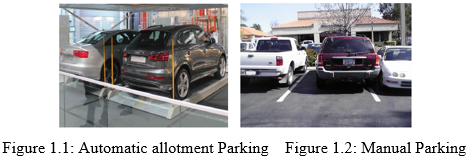
- This depicts that automatic parking is compact whereas manual parking is full of glitches many times which consumes lot of space.
- Over the decades our country has been developed drastically, now we are in this state that we have a lot of well contacted roads, commercial building and increasing number of automobiles.
- While parking these automobiles in parking space we use the manual procedure of parking.
- Which most of the cases is unplanned and lack of discipline due to this, people can park their cars anywhere they want to, which creates a mess as people do not follow the particular cue most of the time.
- As a result of this, a huge traffic jam takes place in that place.
- In our project we are basically designing a parking allotment system where one has to just enter the car at entry gate with sensor and then open the gate and parking allotment system shown on display.
- If the parking area is full, a warning message of “Parking is full!” will be displayed. In this way that person will be able to save his time and energy.
III. OBJECTIVES
The objectives are:
- Introducing automatic vehicle parking system in India and get benefited by it.
- To compare various aspects of this manual parking system with the automated parking system.
- To find out the economic benefits of introducing automated vehicle system.
IV. LITERATURE REVIEW
- The concept for the automated parking system was and is driven by two factors: a need for parking spaces and a scarcity of available land. The earliest use of an APS was in Paris, France in 1905 at the Garage Rue de Ponthieu. The APS consisted of a groundbreaking multi-story concrete structure with an internal elevator to transport cars to upper levels where attendants parked the cars.
- In the 1920s, a Ferris wheel-like APS (for cars rather than people) called a paternoster system became popular as it could park eight cars in the ground space normally used for parking two cars.
- Mechanically simple with a small footprint, the paternoster was easy to use in many places, including inside buildings. At the same time, Kent Automatic Garages was installing APS with capacities exceeding more than a 1,000 cars.
- APS saw a spurt of interest in the U.S. in the late 1940s and 1950s with the Bowser, Pigeon Hole and Roto Park systems. In 1957, 74 Bowser, Pigeon Hole systems were installed, and some of these systems remain in operation.
- Interest in APS in the U.S. was renewed in the 1990s, and there are 25 major current and planned APS projects (representing nearly 6,000 parking spaces) in 2012.
V. BLOCK DIAGRAM
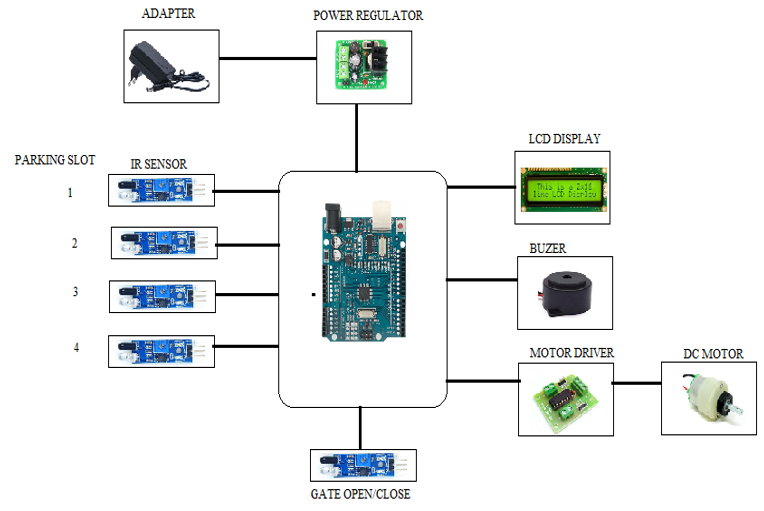
VI. WORKING
The system should have clear-cut information and guide- lines on how a driver is able to interact with the system to find a free space for the successful automated parking of the car. There should be the presence of administrators and proper management for a fully functioning car park. There are a variety of components that are required for the project for its proper functioning and execution with minimal interference from humans.
- Firstly, Power ON the project by connecting 12v adapter to control, board.
- Here 12v is sends to power supply unit. Power supply unit is distributed the power towards all components. We used 7805 IC module for power regulation 12v to 5v DC . This 5 v is transferred to LCD display , Buzzer , IR sensor. While 12v DC is transferred to Arduino Uno Controller (328P) , Motor driver Board.
- Case 1: when sensor 1 is active , Parking slot 1 is Full.
- Case 2; Same for other sensor 2,3,4 is active Parking slot 2,3,4 is Full
- Case 3: when any single sensor is de-active , it means that slot is Empty. In that case Gate at front portion is Open for vehicle.
- Case 4: When all sensor is active , it means that slot is full , In that case Gate at front portion is closed for vehicles. And Buzzer start buzzing.
- All information will show on LCD display.
- S1 : Full /Empty , S2 : Full /Empty Gate : Open /Close
- S3: Full /Empty , S4: Full /Empty.
The LCD display will display the number of available slots and price. When a car will come the operator will send instruction through arduino to open the gate. DC motor helps the gate to open up when it gets the signal from arduino, arduino will only get the signal to DC motor. And availability parking slot will shown on LCD display. As per empty space , car will park.
VII. HARDWARE COMPONENTS
- Arduino Uno
- L293D
- Adapter
- LCD Display
- DC Motor
- IR sensor
- Buzzer
- Resistors
- Capacitors
- Diodes
- Others
A. Software Specifications
- Arduino Compiler
- MC Programming Language: C
- Arduino Uno
Arduino/Genuino Uno has various offices to speak with PC, other Arduino/Genuino boards, or other microcontrollers. The ATmega328 UART provides TTL (5V) sequential correspondence, available on computerized pins 0 (RX) and 1 (TX). An ATmega16U2 on board channels this sequential correspondence over USB and appears as a virtual com port for programming on the PC.

2. IR Sensor
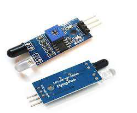
An IR (Infrared) sensor is an electronic device which can be used to sense certain parameters of its surroundings by either emitting or detecting radiations. It can also measure heat of an object and detect motion. It uses the infrared light to sense objects in front of them and map or guess their distance.
3. Liquid Crystal Display
This device can be use to display any message, status or also can be use for debugging purpose. LCD stands for Liquid Crystal Display. LCD is finding wide spread use replacing LEDs (seven segment LEDs or other multi segment LEDs).

4. DC Motor
DC motor is an electrical machine that utilizes electric power resulting in mechanical power output. Normally the motor output is a rotational motion of the shaft. The input may be direct current supply or alternating supply. But in case of DC motor direct current is used.

5. L293D Motor Driver Board
The L293 is simplest and inexpensive for low current motors, For high current motors, it is less expensive to build your own H-bridge from scratch. The L293 is an integrated circuit motor driver that can be used for simultaneous, bidirectional control of two small motors. Small means small. The L293 is limited to 600 mA, but in reality can only handle much small currents unless you have done some serious heat sinking to keep the case temperature down.
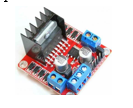
VIII. FLOWCHART
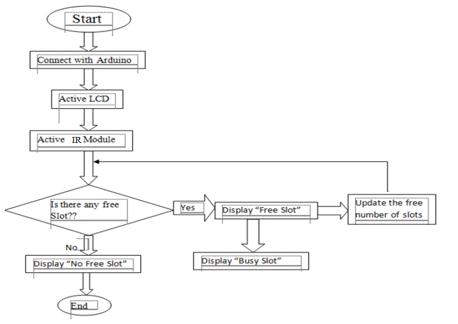
IX. CIRCUIT DIAGRAM
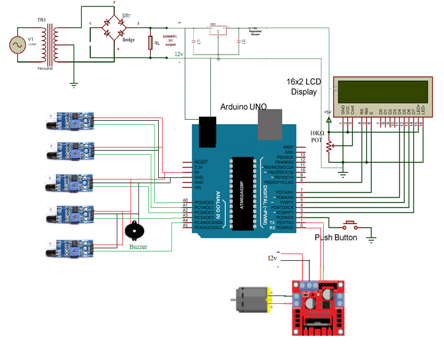
X. ADVANTAGES
- Independent parking & Indoor and outdoor installation flexibility.
- Efficient use of space. The puzzle system is configurable and customized module capacity can be offered.
- Easy and low cost installation.
- Minimal operational cost.
- Easy to drive-in and drive-out.
- Multiple entry/exit & parking/retrieving a car takes less than 180 seconds.
- Safe operation, PLC controlled & low noise level.
- Havoc and waiting during parking is reduced.
- Boon for old-age as well as novice drivers who normally experience biggest difficulty while parking vehicles.
XI. DISADVANTAGES OF AUTOMATED PARKING SYSTEMS (APS)
- It may be costly due to involvement of complex devices for automation.
- If the sensing devices go out-of-order or non-functional then there may be great difficulty in getting cars out of parking, more over it may cause accidents inside parking also.
XII. APPLICATIONS
- By virtue of their relatively smaller volume and mechanized parking systems, APS are often used in locations where a multi-story parking garage would be too large, too costly or impractical. Examples of such applications include, under or inside existing or new structures, between existing structures and in irregularly shaped areas.
- APS can also be applied in situations similar to multi-story parking garages such as freestanding above ground, under buildings above grade and under buildings below grade.
XIII. RESULTS AND DISCUSSION
After doing study on ACP project it is found that ACP systems can be introduced in our country and it will be beneficiary in the context of our country. The main benefits are time and fuel saving. It can also provide sustainable parking management in an eco-friendly manner. As the GHG emission will be less in amount and the surroundings will be clean. There is less maintenance cost for this system so it is helps the property developer in cost saving. It provides security to the parking ground. ACP systems reduce the hassle in parking grounds and traffic jam. It will benefit the property developer to increase their revenue which will add to the government tax revenue. So in a way it is also helping the government by increasing tax revenue. It will also encourage Automation Engineering in our country which will make advancement in increasing usage of technology. Therefore we should introduce ACP systems and enjoy the benefits.
A. Project Image
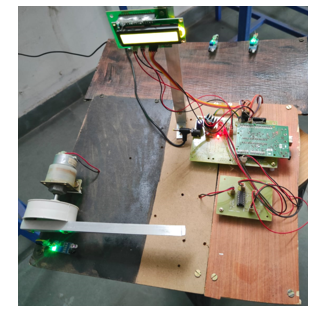
XIV. . FUTURE IDEAS
A. Smart Recognition of Cars
We can recognize the cars by their number plates with the help of image processing in ACP system. By using this type of technology users can directly pay for their car parking using mobile phone’s prepaid balance or car parking account balance.
B. Updating Users about Available slots and Account Balance
User can get updates about available slots of a particular parking space and account balance by sending a simple SMS to the data base.
Conclusion
The various types of smart parking system and has been presented. From the various examples of the implementation of the smart parking system being presented, its efficiency in alleviating the traffic problem that arises especially in the city area where traffic congestion and the insufficient parking spaces are undeniable. It does so by directing patrons and optimizing the use of parking spaces. With the study on all the sensor technologies used in detecting vehicles, which are one of the most crucial parts of the smart parking system, the pros and cons of each sensor technologies can be analyzed. Although, there are certain disadvantages in the implementation of visual based system in vehicle detection as described earlier, the advantages far outweighs its disadvantages.
References
[1] D.J. Bonde, Rohit Sunil Shende, Akash Sambhaji Kedari, Ketan Suresh Gaikwad and Amol Uday Bokre, “Automated Car parking system commanded by androidapplication” [2] Mohammed Y Aalsalem, Wazir Zada Khan and Khailid Mohammed Dhabba, “An automated vehicle parking management and monitoring system using ANPR cameras” [3] M. M. Rashid , A. Musa, M. Ataur Rahman and N. Farhana, A. Farhana, “automatic parking management system and parking fee collection based on number plate recognition” [4] Vanessa W.S. Tang, Yuan Zheng and Jiannong Cao, “An intelligent car management system based on wireless sensor networks” [5] Mala Aggarwal, Simmi Aggarwal and R.S. Uppal, “Comparative implementation of automatic car parking system with least distance parking space in wireless sensor networks [6] Steven Barret, “ Arduino microcontroller: processing for everyone” [7] Afif Mghawish, Akram A. Abdel Qader and Mahmoud A. Al-Jezawi, “Multi-function control system using GSM modem based SM5100B Module” [8] Anita L. Shelke, N.R. Kolhare, R.V. Sarvadnya and Vishal A. Kangne, “wireless RF communication based on DSP” [9] Y.S.E. Ali, S.B. Bashi and M.K. Hassan, “Microcontroller performance for DC motor speed control system” [10] I.G.A.P Raka Agung, S.Huda and I.W.Arta .Wijaya “Speed control for DC motor with pulse width modulation (PWM) method using infrared remote control based on ATmega16 microcontroller” [11] Li Min “The Design of SMS Alarm System on CORTEX M3 + SIM900A” [12] Maria Rodriguez Ferandez, Eduardo Zalama Casanova and Ignacio Gonzalez Alonso “Review of Display Technologies Focusing on Power Consumption”
Copyright
Copyright © 2022 Prof. Pratik Ghutke, Aakash Shankarpale, Shubham Chintalwar, Nutankumar Harshe, Vyankatesh Bhavar, Aditi Dhole, Priyanka Betal. This is an open access article distributed under the Creative Commons Attribution License, which permits unrestricted use, distribution, and reproduction in any medium, provided the original work is properly cited.

Download Paper
Paper Id : IJRASET42529
Publish Date : 2022-05-11
ISSN : 2321-9653
Publisher Name : IJRASET
DOI Link : Click Here
 Submit Paper Online
Submit Paper Online

